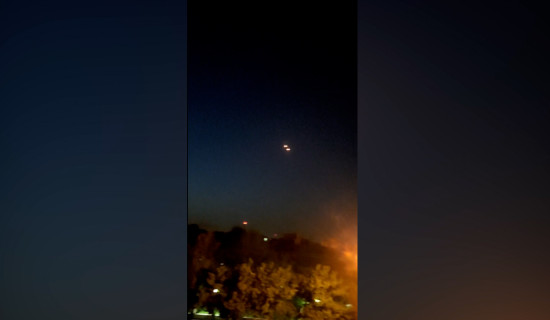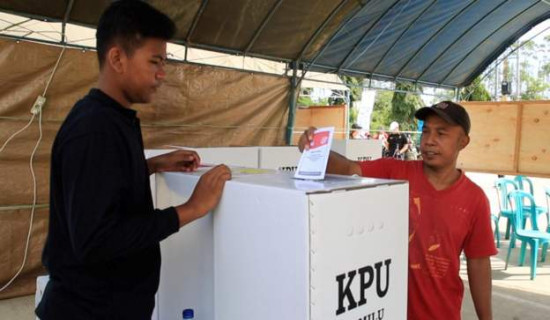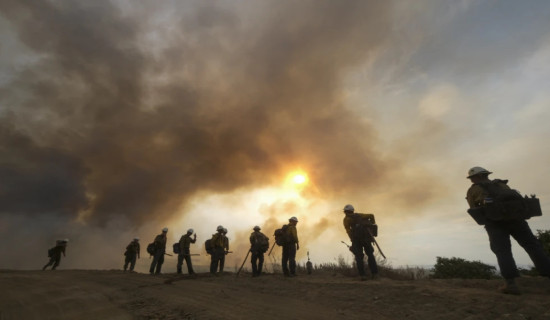- Saturday, 20 April 2024
Powerful typhoon leaves 5 rescuers dead in north Philippines
By JIM GOMEZ and AARON FAVILA
MANILA, Philippines Sept 26 : Typhoon Noru blew out of the northern Philippines on Monday, leaving five rescuers dead, knocking down power in two entire provinces, trapping villagers in floods and forcing officials to suspend classes and government work in and around the capital.
The most powerful typhoon to hit the country this year slammed ashore in Burdeos town in Quezon province before nightfall on Sunday then weakened as it barreled overnight across the main Luzon region, where more than 52,000 people were moved to emergency shelters, some forcibly, officials said.
Gov. Daniel Fernando of Bulacan province, north of Manila, said five rescuers, who were using a boat to help residents trapped in floodwaters, were hit by a collapsed wall then apparently drowned in the rampaging waters.
“They were living heroes who were helping save the lives of our countrymen in the calamity,” Fernando told DZMM radio network. “This is really very sad.”
Authorities were separately trying to confirm the reported death of a man in Burdeos town, where another was injured after falling off a roof he was trying to repair. Police were also verifying that a farmer went missing after his village was inundated by floodwaters in western Zambales province.More than 17,000 people were moved to emergency shelters from high-risk communities prone to tidal surges, flooding and landslides in Quezon alone, officials said.
More than 3,000 people were evacuated to safety in metropolitan Manila, which was lashed by fierce wind and rain overnight. Classes and government work were suspended Monday in the capital and outlying provinces as a precaution although the morning skies were sunny.
The entire northern provinces of Aurora and Nueva Ecija, which were hit by the typhoon, remained without power Monday and repair crews were at work to bring back electricity, Energy Secretary Raphael Lotilla told President Ferdinand Marcos Jr. in a televised meeting the president called to assess damage and coordinate disaster-response.
Marcos Jr. praised officials for evacuating tens of thousands of people before the typhoon hit, preventing more deaths, but expressed concern at how Noru and another storm that devastated central and southern provinces in December rapidly intensified into super typhoons.
“Is this climate change?” Marcos Jr., who took office in June, asked. “We have kept watched on these storms for a long time but it wasn’t like this before. ... This is something I have to deal with.”
Marcos Jr. later joined an aerial inspection of typhoon-hit provinces in the rice-growing region, where many villages and stretches of roads remained flooded.
Noru underwent an “explosive intensification” over the open Pacific Ocean before it hit the Philippines, Vicente Malano, who heads the country’s weather agency, told The Associated Press on Sunday.
From sustained winds of 85 kilometers per hour (53 mph) on Saturday, Noru was a super typhoon just 24 hours later with sustained winds of 195 kilometers (121 miles per hour) and gusts of up to 240 kph (149 mph) at its peak late Sunday.
By Monday noon, Noru had sustained winds of 130 kph (81 mph) and gusts of 160 kph (99 mph) and was moving northwest in the South China Sea toward Vietnam, according to the weather agency.
About 20 storms and typhoons batter the Philippines each year. The archipelago also lies in the “Pacific Ring of Fire,” a region along most of the Pacific Ocean rim where many volcanic eruptions and earthquakes occur, making the Southeast Asian nation one of the world’s most disaster-prone.
In 2013, Typhoon Haiyan, one of the strongest recorded tropical cyclones in the world, left more than 7,300 people dead or missing, flattened entire villages, swept ships inland and displaced more than 5 million in the central Philippines — well to the south of Noru’s path.

.jpeg)



-square-thumb.jpg)




-original-thumb.jpg)

-(1)-original-thumb.jpg)




